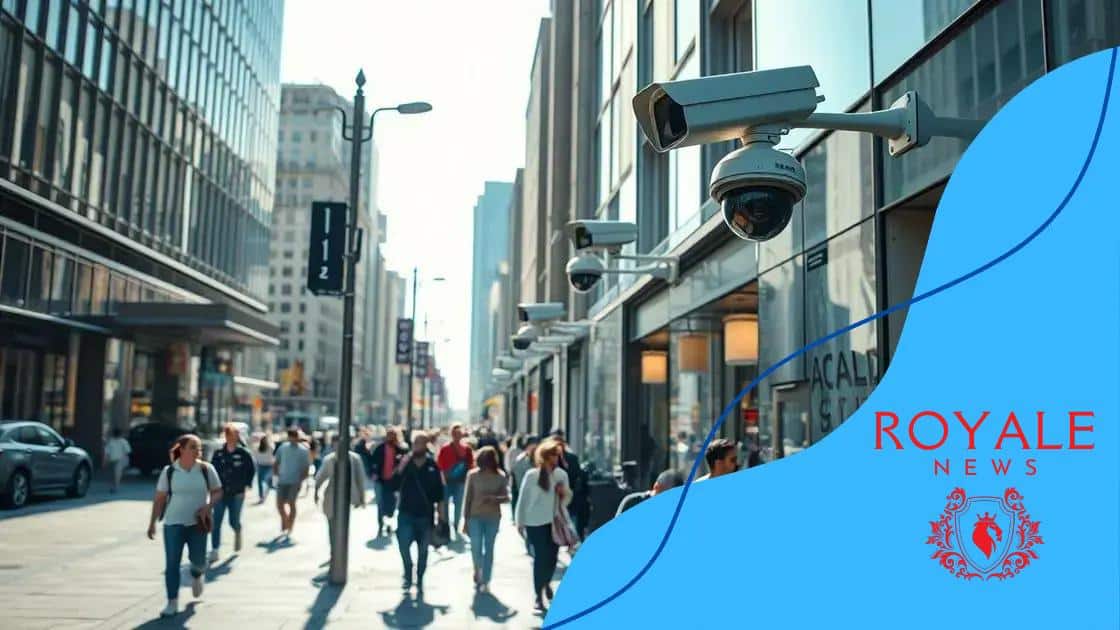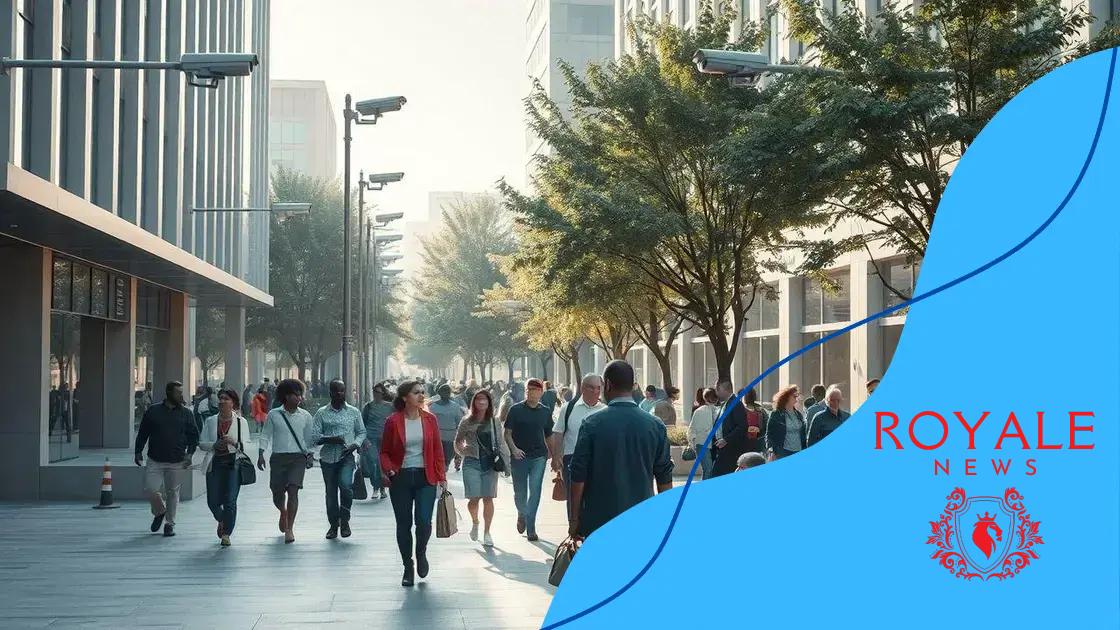The role of facial recognition in enhancing public safety

The role of facial recognition in enhancing public safety includes improving crime prevention, speeding up identification processes, and ensuring efficient security measures at events and in high-traffic areas.
The role of facial recognition in enhancing public safety has become increasingly significant in our everyday lives. It’s fascinating to think about how this technology can help in crime prevention and ensuring safety in public spaces. Curious about its implications? Let’s delve into it.
Understanding facial recognition technology
Understanding facial recognition technology is crucial in today’s world, especially as it plays a prominent role in enhancing safety. This technology helps identify individuals by analyzing their facial features. Let’s explore how it works and why it’s significant.
How Facial Recognition Works
The core principle behind this technology is simple: it captures an image of a person’s face and compares it to a database of known faces. This involves several steps:
- Image Capture: Cameras capture images or videos of faces in real-time.
- Feature Extraction: The software identifies distinct features like the distance between eyes.
- Matching: The extracted features are compared to stored images to find a match.
This process can happen in seconds. The speed and accuracy of facial recognition make it a valuable tool for authorities.
Applications in Public Safety
Facial recognition technology is widely used in various public safety applications. For instance, law enforcement agencies utilize it to track criminals and monitor public spaces. Here are some common applications:
- Surveillance: Cameras equipped with facial recognition can alert authorities if a wanted person is detected.
- Access Control: This technology is used in airports and secure buildings to allow authorized individuals.
- Missing Persons: It helps in finding missing persons by searching public records.
With the rise of smart cities, the potential for facial recognition continues to grow, highlighting the need for a thoughtful approach to its use.
Benefits of facial recognition in public safety
The benefits of facial recognition in public safety are becoming increasingly apparent as technology advances. This innovative system helps authorities ensure security and efficiently address crime.
Enhanced Crime Prevention
One of the main advantages is its ability to prevent crimes before they happen. When surveillance cameras are equipped with facial recognition, they can alert officials to suspicious behavior or identify known offenders. This proactive approach enhances public safety.
Faster Response Times
Facial recognition technology allows law enforcement to quickly identify suspects. This speed can mean the difference between capturing a criminal and letting them escape. Quick identification leads to faster responses by authorities, ultimately creating safer environments in communities.
- Real-Time Alerts: Authorities receive instant notifications about individuals in databases.
- Surveillance Footage: Recorded footage can be analyzed quickly to track movements.
- Collaborative Efforts: Agencies can share information to enhance safety.
In addition, this technology helps streamline investigations. With accurate identification, officers can gather crucial information much faster than traditional methods, making their work more efficient.
Support for Missing Persons Cases
Another significant benefit is its application in finding missing persons. When a case emerges, law enforcement can check their database against public camera feeds. This rapid comparison can lead to successful recoveries of missing individuals.
By employing this technology effectively, communities can harness facial recognition to enhance public safety significantly. Overall, its benefits reflect a step toward a more secure society, with diverse applications supporting safety and efficiency.
Challenges and ethical concerns

While facial recognition technology offers numerous advantages, it also presents significant challenges and ethical concerns. As its use grows in public safety, discussions about its impact are increasingly important.
Privacy Issues
One of the main concerns relates to privacy. Many people worry that constant surveillance leads to an invasion of their personal space. When cameras scan faces in public areas, it raises questions about consent. Are individuals aware they are being recorded? This lack of transparency can erode trust between the public and law enforcement.
Accuracy and Bias
Another challenge is the accuracy of facial recognition systems. These systems can make mistakes, especially in identifying individuals from diverse backgrounds. A high rate of false positives can result in innocent people being wrongly accused or targeted.
- Discrimination Risks: Some studies show that facial recognition can be less accurate for people of color, raising concerns about systemic bias.
- Over-Reliance on Technology: There’s a risk that authorities may depend too heavily on facial recognition, which could lead to overlooking traditional investigative methods.
- Technology Vulnerabilities: Like any digital system, facial recognition can be hacked or manipulated, posing additional risks.
These ethical concerns highlight the need for regulations. Policymakers must strike a balance between leveraging technology for safety and protecting citizens’ rights. Open dialogue and clear guidelines are essential to navigate these complex issues.
Future trends in facial recognition
The future trends in facial recognition technology look promising as advancements continue to emerge. With ongoing research and development, this technology is set to evolve further, increasing its role in public safety and various other applications.
Integration with AI
One significant trend is the integration of facial recognition with artificial intelligence (AI). This combination enhances the accuracy and efficiency of recognition systems. By utilizing machine learning algorithms, systems can improve over time, learning from past data to make better identifications.
Usage in Smart Cities
Smart cities are beginning to adopt facial recognition as part of their security infrastructure. This technology can monitor public spaces, regulating traffic, and tasks. With better data collection, cities can respond to incidents swiftly, creating safer environments for their citizens.
- Real-Time Analytics: Enhanced data analysis allows for immediate responses to suspicious activities.
- Seamless Interconnectivity: Systems will connect with various platforms, sharing data to improve public safety.
- Personalized Services: Businesses may use facial recognition to enhance customer experiences in retail spaces.
The rise of wearable technology also plays a role in the future of facial recognition. Devices like smart glasses will incorporate this technology, enabling users to access information instantly, such as identifying people or providing context about surroundings. As technology becomes more prevalent, public acceptance could grow, leading to wider applications.
Regulatory Developments
As use increases, regulatory frameworks will likely evolve. Governments and organizations will need to establish guidelines to ensure ethical practices in deploying facial recognition technology. These regulations must balance security needs with individuals’ rights to privacy, fostering a responsible approach towards this powerful tool.
Real-world case studies of successful implementations
Real-world case studies of successful implementations of facial recognition technology showcase its potential to enhance public safety and efficiency. These examples provide insight into how different sectors have adopted this technology effectively.
Law Enforcement Applications
Many police departments have integrated facial recognition to solve crimes. For instance, in a major city, authorities used facial recognition software to identify a suspect in a robbery case within hours. The software quickly matched the suspect’s face captured on surveillance cameras with a database of known offenders.
Event Security Enhancements
Large events, such as concerts and sports, have also embraced facial recognition systems. At a high-profile music festival, organizers deployed facial recognition to manage crowd safety. Cameras scanned attendees’ faces to detect any individuals with active warrants. This practice not only improved safety but also provided a smoother entry process.
- Live Monitoring: Security teams monitored real-time footage to respond quickly to any incidents.
- Personalized Experiences: Utilizing facial recognition allowed for customized services, enhancing attendee engagement.
Another notable case is in airports, where facial recognition speeds up the boarding process. Passengers can simply walk through the gate, and the system verifies their identity against flight records. This innovation improves efficiency and reduces waiting times.
Healthcare Facilities
In healthcare, hospitals have implemented facial recognition for patient identification. This system helps in verifying identities before procedures or treatments. By minimizing the risk of misidentification, it enhances patient safety and staff efficiency.
Such successful implementations of facial recognition highlight its versatility and effectiveness across various fields, paving the way for future enhancements and broader acceptance in society.
facial recognition technology has the power to enhance public safety significantly. Its successful implementations across various sectors demonstrate its effectiveness. However, as we look to the future, it’s vital to address the ethical concerns surrounding privacy and accuracy. With the right regulations and advancements, this technology can continue to evolve, ensuring safety while respecting individual rights. The ongoing dialogue about its use will shape the future of facial recognition and its acceptance in society.
FAQ – Frequently Asked Questions about Facial Recognition in Public Safety
How does facial recognition enhance public safety?
Facial recognition technology can improve public safety by quickly identifying suspects in real-time, helping law enforcement respond to incidents more effectively.
What are the main ethical concerns regarding facial recognition?
The main ethical concerns include privacy issues, potential bias in identification, and the need for transparency regarding data use and consent.
Can facial recognition technology be used at large events?
Yes, many large events use facial recognition for security, allowing quick identification of individuals with active warrants and ensuring a safer environment.
What are some successful implementations of facial recognition technology?
Successful implementations include use in law enforcement for solving crimes, in airports for speeding up boarding processes, and in hospitals for patient identification.





